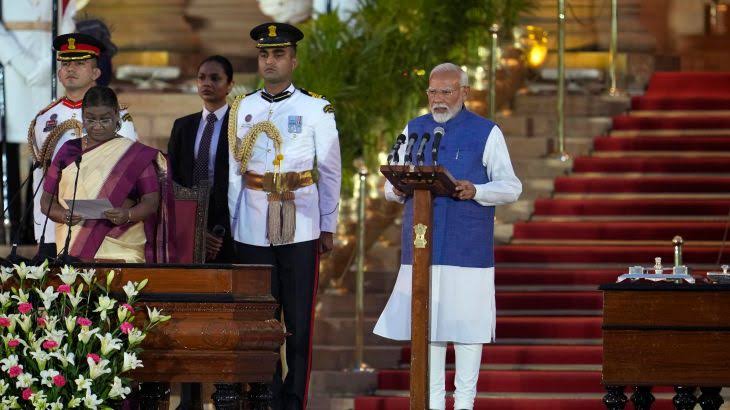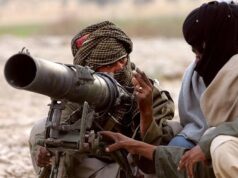During third-term, Modi may take some bold steps centering Pakistan-occupied Kashmir

Critics of Narendra Modi and geopolitical naïve are indulging in delusional perception by seeing his straight third-term as “weak” and the government as “fragile”. They are even predicting an “imminent collapse” of the NDA-alliance government, stating, during this term, Narendra Modi shall be compelled to bow to American dictation and pressure thus letting Washington implement its plots in the region, which includes regime change in Bangladesh – latest by the end of this year
Such perceptions or predictions are naïve at the least.
Narendra Modi’s third consecutive term not only cements Modi’s dominance within India but also poses significant ramifications for neighboring countries and the global stage. Despite a challenging election where his party, the Bharatiya Janata Party (BJP), fell short of an outright majority and now relies on coalition partners, Modi’s leadership is set to continue shaping India’s internal and external policies.
Modi’s re-election signals continuity and potential intensification of India’s assertive stance towards its neighbors, particularly China and Pakistan. Relations with Pakistan have been strained since long , characterized by heightened military tensions and nationalist rhetoric. This dynamic may persist as Modi seeks to maintain his strongman image domestically, especially given the coalition government’s potentially limited maneuverability in policy changes.
China, the main neighbour, presents a complex challenge for India. The Indo Tibetan border disputes and military standoffs on LAC , such as the 2020 Galwan Valley clash, have underscored the contentious relationship. Modi’s government will continue te military and strategic buildup along the disputed LAC while seeking to balance economic engagements with China, an approach that has defined much of his foreign policy. However, Bangladesh will be a top priority in terms of bilateral relations with neighboring countries. Bangladesh is regarded as a crucial partner for maintaining India’s territorial integrity.
On the global front, Modi’s victory ensures that India will continue to play a pivotal role in international politics. Modi has successfully positioned India as a key player in global issues such as climate change, economic development, and Asian security. His government’s working with the United States, particularly within the framework of the Quad alliance (comprising the US, Japan, Australia, and India), is expected to deepen. This coalition aims to counterbalance China’s influence in the Indo-Pacific region, and Modi’s renewed mandate will likely see an expansion of defence and technological cooperation with these partners.
India’s strategic autonomy, a cornerstone of Modi’s foreign policy, means maintaining robust ties with Russia despite Western pressure to distance from Moscow due to the Ukraine conflict. This balancing act reflects India’s broader goal of emerging as a leader of the Global South, advocating for a multipolar world order not dominated by any single superpower. India is now a power own its own too .
Following the swearing in ceremony of Narendra Modi on June 9, state machineries in India will likely undergo strategic adjustments to align with the central government’s policies. Given the coalition nature of the new government, there may be increased emphasis on regional cooperation and power-sharing agreements. State governments, especially those led by BJP allies, might see a boost in support and resources to ensure the stability of the coalition. Conversely, states governed by opposition parties may face heightened political tensions and resource allocation challenges.
In this term, the Modi government is likely to exert significant pressure on the opposition, especially aiming to fracture the INDI (The Indian National Developmental Inclusive Alliance) alliance. A carrot-and-stick approach will be employed to coerce or incentivize opposition members, leveraging both power and financial incentives—a common tactic in the subcontinent’s political landscape. Historically, politicians in this region have often succumbed to such pressures. Rahul Gandhi, the Congress opposition leader, will face considerable challenges in maintaining the cohesion of the alliance. The government’s strategy will test his ability to keep the opposition united.
On Pakistan-occupied Kashmir (PoK), Modi is expected to adopt a more assertive stance and there is a strong possibility that by 2027, he may approve offensive actions that could be perceived as an invasion, using rhetoric to galvanize domestic support. Under Modi’s leadership, PoK shall be liberated and made an integral part of Indian territory, where a financially bankrupt Pakistan shall not have the energy to fight mighty Indian forces. Furthermore, by that time, Pakistan’s political landscape shall also substantially change – with Imran Khan released from prison and possibly turning into a genuine threat to ruling elites and their masters – Pakistani military and intelligence establishments.
This strategy centering PoK would likely dampen opposition voices, branding any dissent as unpatriotic or aligned with Pakistani interests. India already has 2/3 of Kashmir, which has been a focal point of conflict with Pakistan. Under Modi’s previous terms, the revocation of Article 370, which granted special autonomy to Jammu and Kashmir, marked a significant shift in the region’s status, leading to increased administrative changes.
Modi’s government is anticipated to adopt a dual approach of assertiveness and strategic diplomacy. Domestically, the government will likely continue its agenda, focusing on economic reforms, infrastructure development, and strengthening internal security. Internationally, Modi’s administration will strive to enhance India’s standing as a major global power. Strengthening ties with the US, expanding influence in the Indo-Pacific, and maintaining strategic autonomy through diversified alliances will be key components of his foreign policy. Modi’s leadership will also focus on leveraging India’s economic potential to attract foreign investments and bolster global trade relations.
Narendra Modi’s third term as Prime Minister represents a critical juncture for India. His continued leadership is set to influence not only India’s domestic landscape but also its regional and global interactions. The impact on neighbouring countries, particularly Pakistan and China, will be closely watched, as will India’s role in global geopolitics. The coalition nature of the new government introduces elements of unpredictability, but Modi’s established strategies provide a roadmap for India’s future trajectory.
The best “magic lamp” for Narendra Modi to once again become the most popular politician in India and a national hero is freeing PoK from Pakistani occupation. And for a seasoned and patriotic leader like Modi, achieving this goal is not mission impossible.
As Modi navigates the complexities of coalition governance, his administration’s actions will significantly shape India’s path in the coming years. The global community will be keenly observing how Modi leverages his renewed mandate to address both domestic challenges and international opportunities, solidifying India’s position on the world stage. Above all, under Narendra Modi’s leadership, relations between Bangladesh and India shall further deepen, where there will be no scope of Islamist forces in regaining its lost vigor.
Blitz




